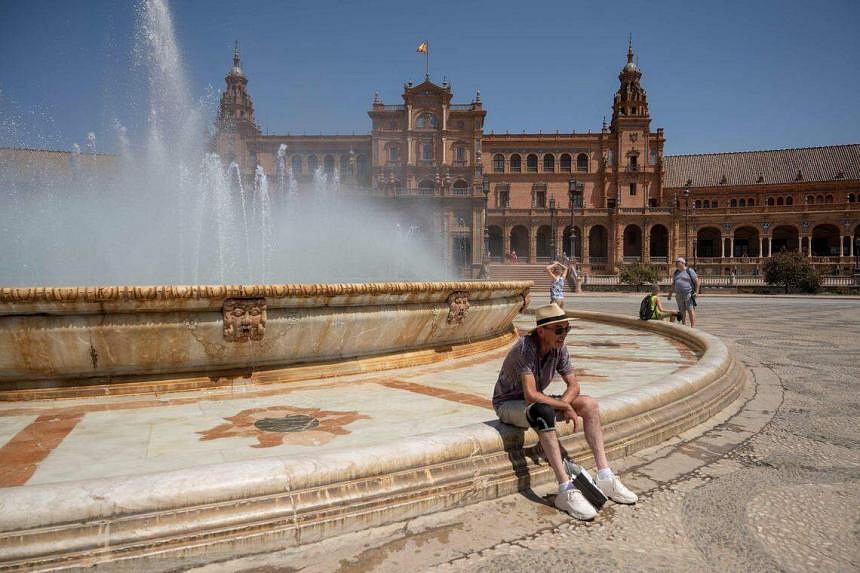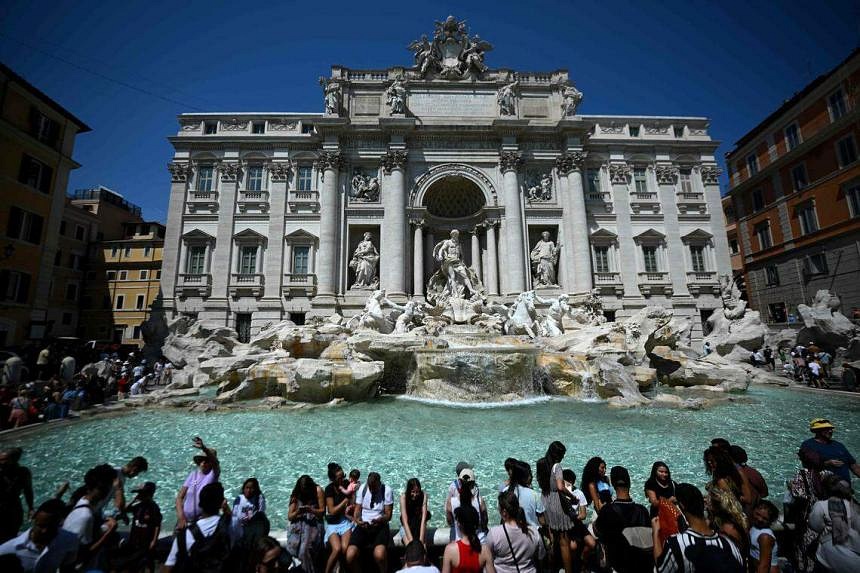Ms Kia Karjalainen and her sister were vacationing in Greece when things took an unexpected turn.
“We were in our hotel room and I suddenly said to my sister, ‘It really, really smells of smoke. Is something burning?’”
It was mid-July on the island of Rhodes and wildfire smoke was heading in their direction.
Planes flew over their hotel pool, carrying water to the fires. Everything, including their clothes, was covered in a fine layer of ash.
Ms Karjalainen, 24, a London-based events coordinator, tried to move up their flights home, but everything was booked.
“You don’t want to put yourself in danger or other people,” she said. “You have to think of the locals and how it vastly impacts them.”
She was hardly the only traveller to have an eye-opening experience during the summer of 2023, when the effects of climate change – heatwaves, floods, wildfires, extreme storms – seemed to crop up in every corner of the world.
July turned out to be the planet’s hottest month on record, while the period from June to August was the Northern Hemisphere’s hottest summer.
As temperatures soared, parts of western Europe slogged through long-running drought conditions, while places from Brazil to the Himalayas were inundated with floods or landslides.
And then there were the wildfires in Maui and Texas in the United States, as well as in Canada, France, Portugal, the Canary Islands – and Greece.
It was a summer of extremes, and a summer of lessons for the travellers and locals who encountered them.
Looking ahead, here are some lessons from the climate change upheavals of the past few months.
One thing is clear – unpredictability is the new normal.
1. Look for new ways to keep cool in cities
The world’s cities were on the front lines this summer, and many are trying to get out in front of the weather.
In Athens, where temperatures spiked to 40 deg C in July, the authorities closed the Acropolis in the middle of the day. They also installed shades to offer protection from the sun.

In August, the authorities at the Colosseum in Rome began offering early-morning tickets, allowing visitors accompanied by an official tour guide to enter from as early as 7.30am.
And in Paris, Berlin and Washington, DC, some pools and parks were kept open until as late as midnight during heatwaves.
The organisers of next summer’s Olympic Games in Paris are planning ahead to beat the heat.
The nearly 40-year-old Bercy Arena, site of the gymnastics competitions, is getting air-conditioning – which is relatively uncommon in Paris and many other European cities – while the glass-roofed Grand Palais will be equipped with temporary air-conditioning, as well as a huge shade.

At outdoor sites, visitors can expect to find shelters, beverage stations and misting zones.
Miami, Phoenix, Los Angeles, Melbourne, Athens and Freetown, Sierra Leone, are among the cities that have recently installed “chief heat officers” to create public warning systems, expand green spaces and build “cooling centres”, among other measures.
Washington, DC, has launched Keep Cool DC, which aims to plant trees, invest in parks and promote heat-sensitive building design.
In Spain, Seville may soon name and categorise heatwaves so people can prepare as they would for hurricanes.
Ms Angie Moreno, Seville’s councillor for tourism, said: “If heatwaves are categorised by their health impact level and the most hazardous ones are named, citizens can effectively protect themselves.”

Ms Gabby Beckford, a travel content creator who visited Seville in June, was struck by how well the infrastructure was adapted to heat.
The city was designed “to work with the sun’s daily path and to keep as much shade in the city as possible”, she said, noting the narrow alleyways and shaded roads and paths.
2. Shake up your travel timing
Spaniards are known for arranging their days around heat, Ms Beckford said.
“Outsiders might have looked at the siesta culture as lackadaisical,” she added, but Spaniards “truly use it as a means of survival”.
In Spain and beyond, visitors are also starting to avoid sightseeing during the hottest hours.
Ms Isabella Calidonna, an art historian and tour guide in Rome, was surprised to discover during a recent early-morning tour that the Trevi Fountain was crowded at 6.10am.
“People are starting to change the timing of their visits. They’re leaving for the day earlier,” she said.

Along with planning activities for cooler times of the day, avoiding peak summer travel is another timing shift that is coming.
Some tour companies are already emphasising cooler months.
Mr Sebastian Ebel, chief executive of TUI, said the company plans to extend its travel season into the spring and autumn.
“We will go into Greece to the middle of November, and I asked my colleagues, maybe we should open it until the end of the year, until or after Christmas,” he added.
3. Prepare for bumpier skies
It was not an easy summer for nervous fliers.
In August, 11 people were taken to the hospital after a Delta Air Lines flight from Milan to Atlanta encountered severe turbulence.
In late June, turbulence on a Hawaiian Airlines flight from Honolulu to Sydney sent several unbelted passengers flying into the air.
Such incidents are not new, but researchers have found that clear air turbulence – rough air that comes on suddenly in cloudless skies – has increased significantly at aircraft-cruising altitudes over the past four decades.
Other researchers predict that climate change will exacerbate the phenomenon, as well as incidents of turbulence above mountain ranges and around clouds.
Other issues include overheated tarmacs and the strain that high temperatures put on aircraft.
The wings of planes achieve less lift in warmer temperatures, which means they require longer runways for take-off, while the heat also hinders the performance of jet engines.
In a few cases, high temperatures have forced airlines to bump passengers off or reduce fuel load to make planes light enough to take off.
In other cases, temperatures have exceeded the maximum at which aircraft are allowed to operate, forcing cancellations.
4. Expect the unexpected, in and on the water
On a visit to Montana in August, Mr Joe Zocchi, a retired attorney, was unable to fish in the Big Hole River as much as he had hoped.
“Our fishing was curtailed,” he said, by restrictions “that prohibited fishing in the afternoon once the water temperature reached 68 degrees (20 deg C)”.
Such restrictions kick in when waters get warm enough to stress coldwater fish.
Rivers in Europe are also feeling the effects of climate change. Tour operators have cancelled cruises on the Rhine, the Danube and the Elbe because of low water levels.
And the ocean is not behaving as expected.
Mr Sven-Olof Lindblad, founder and chief executive of the luxury cruise company Lindblad Expeditions, said climate shifts have made storms harder to anticipate, as historic data have become a less reliable indicator of where and when rough weather will occur.
“There is more unpredictability in the system,” he added, saying that the “possibility of disruption” is higher now than in the last 50 years.
5. Expect more visitors to cooler climates
Cooler areas, including northern Europe, could see a significant rise as travellers look to avoid encounters with intense heat.
Ms Liisa Kokkarinen, head of sustainable development at Visit Finland, said the country has seen an uptick in visitors, especially from Asia and elsewhere in Europe.
“Something that was in the past considered ‘too cold to visit’ is maybe no longer too cold to visit,” said Ms Kokkarinen, who lives in Lapland, along the Arctic Circle.
Typically, the high season there is winter, with travellers coming for the snowy landscapes and Northern Lights.
But now, more visitors are enjoying the mild summers – something the government tourism agency is working to support.
“In Finland, people return to school and work in August, so there is space for international visitors,” she said. “We don’t see the pressure, because that’s actually our low season.”
6. Build in flexibility
Storms, heatwaves and wildfires are anything but predictable, and travellers are increasingly building in ways to change their plans on the fly.
Mr Jared Brenner, an American who recently retired to Lisbon, Portugal, said he will pay more for refundable or flexible flight tickets, or look for flights with smaller change or cancellation fees.
He and his wife have also begun signing up for organised trips, which offer an extra layer of support in the event of the unexpected.
“For years, we booked things ourselves, but from now on, we’ll think about group trips,” he said.
On the accommodation front, travellers should check the refund and cancellation policies before booking, as policies vary.
Travel insurance can offer some protection, but those who are stuck paying for a non-refundable room can try to sell it on a site like SpareFare, or Eluxit, which allows travellers to resell prepaid trips.
People are also thinking more about how they will manage if things go wrong, said Mr Henry Harteveldt, a travel analyst at Atmosphere Research Group.
They are keenly aware that things can and do go wrong, he said, and some are even reserving back-up hotel rooms or rental cars.
7. Know that you can run, but you cannot hide
On a June trip to the Colorado Rockies, Mr Sasha Lezhnev of Virginia was driving to meet his wife and son when he encountered what looked like a mini-tornado.
“The dust devil was running across the road and there was nothing I could do. You just hope your car doesn’t spin around,” he said, adding that they also endured a series of tornado watches during the trip.
Mr Lezhnev, founder of the travel website Off The Beaten Travel, said the experience and others like it, including a close brush with a summer wildfire in Montana, have led him to consider places like Maine, Scotland, Finland and Norway, which are known for their relatively cool, calm climates.
But even northern Europe is not immune to upheaval. Finland and Norway saw heavy rains this summer.
Travellers “are keenly aware that things are different now”, said Mr Harteveldt. “And you cannot just plan a trip without doing some research and having some level of awareness about your destination and potential risks.” NYTIMES

